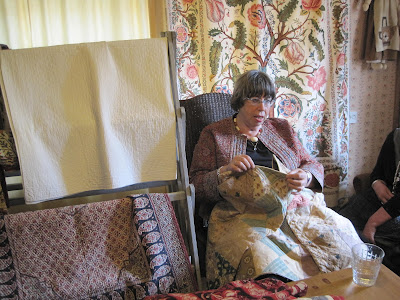 It always feels like a party going to Bep!!!! Her shop, kitchen and garden are always full with suprises and little treasures. Today she had organized a lecture about the dutch quilt history by An Moonen. THANKS BEP!
It always feels like a party going to Bep!!!! Her shop, kitchen and garden are always full with suprises and little treasures. Today she had organized a lecture about the dutch quilt history by An Moonen. THANKS BEP! It's amazing how many people she can put in her livingroom: 19 ladies, 1 man, 1 small dog and the cat on the table. Really, I met the first dutch male quilter (that I know). There are probably or hopefully more men who like to quilt here in the Netherlands. Here is Gert's blog, "real man stitch and sew" where he's telling about his quilt adventures.
It's amazing how many people she can put in her livingroom: 19 ladies, 1 man, 1 small dog and the cat on the table. Really, I met the first dutch male quilter (that I know). There are probably or hopefully more men who like to quilt here in the Netherlands. Here is Gert's blog, "real man stitch and sew" where he's telling about his quilt adventures. An Moonen : is an independent Antique Textile Historian residing in Westervoort. For 3,5 hours she talked about the dutch quilt history, and showed us some of here 17c, 18c and 19c quilts. Dutch quilts from this period don't have bindings, mostly made of triangles, or just one piece of fabric (a panel we would day nowdays) and as fabric they often used chintz fabrics. Typical for dutch quilts from that period is a quilted 8-pointed star in the middle. The back was often made of silk, and they quilted the back of the quilt not the front. Quilting was done by the upper-class, rich ladies with lots of time ; ).
An Moonen : is an independent Antique Textile Historian residing in Westervoort. For 3,5 hours she talked about the dutch quilt history, and showed us some of here 17c, 18c and 19c quilts. Dutch quilts from this period don't have bindings, mostly made of triangles, or just one piece of fabric (a panel we would day nowdays) and as fabric they often used chintz fabrics. Typical for dutch quilts from that period is a quilted 8-pointed star in the middle. The back was often made of silk, and they quilted the back of the quilt not the front. Quilting was done by the upper-class, rich ladies with lots of time ; ).Our connections with the far east had a great influence on the prints, colours and fabrics that were used. For some reason in the 20c the dutch quit quilting, but at the end of the 20c there was a revival.
And now there at least 13.000 woman and 1 man in the Netherlands who like to quilt.




















